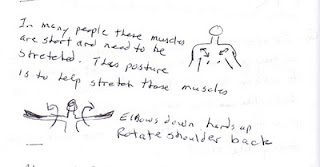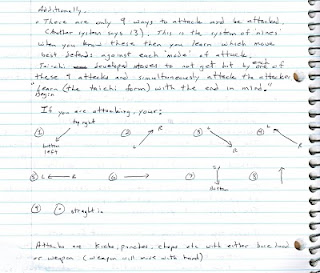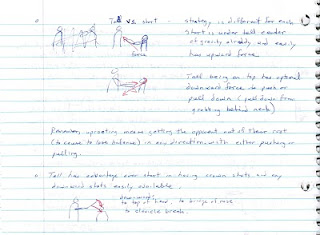* Question: I used to feel sinking down and head rising up as two movements and would get confused as to where the split point occurred. Now it feels like I'm a gooey blob trying to pick it up from the center. Is this the "sink the chi and raise the shen" feeling?
Answer: If you make a human form out of Silly Putty and stand it up, eventually it will compress down under gravity because there is no harder structure inside it. (If you don't know what Silly Putty is, you can see a circa 1970's Silly Putty TV commercial.) The oozing down feeling are the muscles relaxing and hanging on the structure, your skeleton, and the rising up feeling is the feeling opposite; the skeleton remaining erect as the muscles release and relax. Both feelings arise together as a result of relaxing. As you've experienced, you don't have to try to create either feeling, just relax.
* Question: I felt what I want to call "the chi drop" but I haven't gotten that feeling again. What am I doing wrong?
Answer: Feeling the "chi drop" is a milestone feeling. That's OK. Now you know the feeling. Keep practicing and it will present itself again.
(Note: Wujifa does not operate in the "Chi paradigm". Because of my history with Tai-chi and "Chi paradigm" stuff, I tended at that time to try to frame my experiences using the terminology I was most familiar with.)
* Question: Is the side-to-side closing feeling like a squeezing feeling? (I demonstrate.)
Answer: You're doing it wrong. It's more like a folding. It's not so much compressing from the top. It's more just moving across and folding in.
* Question: Can relaxing the pelvic floor muscles allow other muscles to relax and change the body structure?
Answer: You already answered your own question. You've already felt that to be true.
* Above all, find fun and enjoyment in your practice. If it becomes a chore, a duty, an obligation, a discipline, well, then you've got another problem.
* While doing stance in class, I thought I was sinking OK. After receiving a quick series of adjustments to my right leg and hip, suddenly my right thigh swelled with pressure. We both knew, "there it goes". I need to find this feeling in my own practice.
* Question: I don't understand the relation between stance and side-to-side exercises and the development of internal strength.
Answer: It will come to you. Keep practicing.
* You don't need to stand low. The problem with adjusting people is that they ratchet themselves lower and lower because they don't want to relax what they need to relax to get the feeling in a higher stance.
* When told to "drop the chest", many people will hunch and the shoulders will roll forward. This is the wrong structure. It is the muscular tension held in the upper chest that must release, relax, drop. The shoulders should remain in their position and not move when dropping the chest. One stance practice is to hold the arms out to the sides, elbows down, palms up. Also, make sure to maintain a line from ear to ankle perpendicular to the floor. Don't pull the shoulders back (don't pinch the shoulder blades together), rather, relax, extend, open. Relax, extend, open.

* One way to help stretch tight upper chest muscles is to enlist the help of a couple trusted school brothers or sisters. Lie on your back on the floor. Have one person straddle your body facing you and firmly holding your shoulders down. Have another person behind the top of your head put a hand on the center of your chest and firmly and s-l-o-w-l-y press down and toward your feet. Most people carry a lot of tension in the chest and will feel a real stretch.

(If you try these chest and shoulder exercises, make sure you are in a safe, supportive environment. Notice and honor any resistance. There is something to be learned where we resist letting go.)
* The "Grandma's Spice Cake" story. Grandma made spice cake but never used a recipe. If eggs were cheaper, she'd use more eggs. If milk was cheap, she'd use more milk. If the weather was hot and humid, she'd use less water. Regardless of how much or little of whichever ingredient she used, it always tasted the same. One day, the grand-kids, now adults, wanted to know how to make grandma's spice cake so they noted her ingredients and measured her amounts. When the kids tried making grandma's spice cake from that recipe, it did not taste like grandma's spice cake. So they asked her, "Grandma, what are we doing wrong?" She said the problem is that you're following a recipe. "But if we don't follow the recipe then how do we know how to do it?" She said, "You develop a feel for it."
Practicing zhan zhuang is like making grandma's spice cake. The teacher knows by feel from years of practice what to do; on this student, adjust here, on that student, adjust there. Each student tries to "get it" from following the recipe. The trouble (if you're looking for a one-size-fits-all approach) is that everyone is different. Each person gets a different "recipe". There is no single recipe and applying a single recipe to all students will not work equally well for all.
The "recipe" is the proverbial "finger pointing at the moon". It is not the moon itself. So, follow the recipe but don't follow the recipe. Yes, the same basic ingredients are mixed in the same basic fashion but make adjustments according to the individual at that time to get the desired result.
* Exercise to help open the inguinal crease. (What I will describe is kind of like a face-down deep ma-bu.) Depending on level of flexibility... Get on knees and elbows with knees at hip level and elbows at about nipple level. Place hands on opposite elbows. Feet perpendicular to the floor. Head hangs down. Back straight. If it helps, lay a flat, straight piece of wood on the back from pelvis to head and ensure that the back stays in contact with this. Spread the knees out as far as possible until you feel a stretch. Push the butt back without physically moving/shifting back. Feel the stretch from head to tailbone. Once you get the proper alignment in this posture then you can begin two exercises:
- Side to side - slightly shift the pelvis left to right with the intention of pulling the knee toward your head on the side shifting into. Ensure the shoulders stay level.
- Rotate the pelvis - tuck under and untuck up
(I include this exercise here for informational purposes only as another example of one of the wide range of exercises we practice to help open and relax the body. If you try to do this on your own from only reading this description, you will likely do it wrong and not get any benefit. You really need someone who can get you "set up" correctly, read how your body is responding, and coach you according to your specific kinesthetic response. Many exercises are tailored to specific individual situations. How I am stuck is likely not how you are stuck.)
* The adjustments I receive to my stance in class seem to be getting smaller and smaller, finer and finer. When and as I practice on my own, I need to stop moving around so much and really be still and make only one tiny adjustment and wait to feel the result.
(I think I'm referring to what we dubbed, "stance dance". This occurs when in the course of stance, I'm continuously checking my structure, 1,2,3,4 - 1,2,3,4 and as I finish the last "4" then I notice the first "1" is wrong and I go through another series of adjustments and again and again and never stand still, hence, the term, "stance dance". - - If you're not familiar with 1,2,3,4 - 1,2,3,4 then see the Zhan Zhuang Alignment article at the Wujifa site.)* Today I did the step-stool exercise. Wow! That was tough! But how great it feels afterward! So much more open! Amazing!
Interestingly, the stance dance topic came up in class yesterday, albeit, at a much more subtle or finer level of noticing and feeling than discussed in this entry six years ago.)
(Another specific exercise used to help open the body and I think, better left not described.)Further reading:
Introductory article explaining this "Journal Notes" series: Zhan Zhuang Training Journal
Previous article in this series: Monkey and Stallion: Journal Notes #23
Next article in this series: More Pelvic Work: Journal Notes #25











